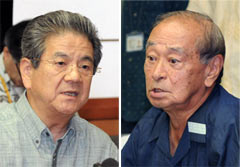Governor Nakaima criticizes the Defense Minister’s notification of the plan to build the V-shaped runway at Henoko

Defense Minister Toshimi Kitazawa (left) meets with the Governor Hirokazu Nakaima (right) at the Okinawa prefectural office on June 13, telling him that they will build the V-shaped runway of the U.S. Marine Corps Futenma Air Station replacement facility at Henoko.
June 14, 2011 Ryukyu Shimpo
On June 13, Defense Minister Toshimi Kitazawa met Okinawa Governor Hirokazu Nakaima at the prefectural office to formally tell him that the governments of the United States and Japan will decide to build a V-shape runway for the replacement facilities for the U.S. Marine Corps Futenma Air Station, at Henoko, Nago City, at the US-Japan Security Consultative Committee for defense ministers and foreign ministers (2 + 2) scheduled to be held on June 21.
The governor repeatedly asked the defense minister to relocate the Futenma Air Station out of Okinawa and indicated his dissatisfaction with the policy of Tokyo and Washington, saying, “If both governments do decide on this plan it will not proceed without the consent of the residents. This is indeed unfortunate and regrettable.”
A sit-in protest against the Osprey vertical takeoff and landing deployment plan to Futenma by residents, including Ginowan City Mayor Takeshi Asato was held. People’s opposition to government policy is growing within the prefecture.
Meanwhile, in the United States, the Chairman of the Senate Committee on Armed Services Carl Levin and other leading lawmakers judged it to be “unrealistic,” to relocate the facilities and functions of Futenma to Henoko, and proposed the merger of Futenma and Kadena Air Base. Former CIA chief Leon Panetta, who will become the new Secretary of Defense, is reported to be flexible with regard to reviewing the “Futenma-to-Henoko” plan.
Negative opinion regarding this plan has started to appear in the United States and the governments of the two nations clearly lack the ability to convince the Okinawan people and the U.S. Congress.
The governor told the defense minister, “The basic premise of this discussion is that the facilities at Futenma should be moved as soon as possible and that residents be released from the dangerous situation they currently find themselves in. I think that the relocation of the air station to another prefecture is the quickest option.”
In response, with regard to the deployment of the MV-22 Osprey to Futenma, Kitazawa explained, “The risks and technical difficulties with the aircraft are resolved.” Nakaima replied by saying, “Accidents involving this aircraft are still clear in my memory. I cannot agree with the offer that you will bring to those living in the middle of our city,” and continued, “You are trying to do something akin to putting them in Hibiya Park in Tokyo.”
With regard to the deadline of “2014” that both governments agreed to in the Futenma relocation plan, the defense minister said, “It is difficult to complete in practice,” and “We are concerned that the facilities Futenma may become immovable, so we need to make arrangements in order to achieve the plan as soon as possible.”
With regard to measures to reduce the burden on Okinawa, Kitazawa referred to the discussion of a partial deactivation of the “Hotel-Hotel” training area off the northeastern coast of the main island of Okinawa, saying, “We are negotiating with the United States for a full return.”
(English Translation by T&CT, Mark Ealey)
Previous Article:Heads of 38 municipalities oppose the deployment of MV-22 Osprey at Futenma Air Station
Next Article:Ginowan Mayor’s sit-in-protest against the Osprey deployment
[Similar Articles]
- Defense Minister Kitazawa meets Governor to emphasize the policy to relocate the Futenma facilities to Henoko
- Minister of Defense refuses to meet Nago Mayor
- Nago Mayor demands the withdrawal of the Henoko plan to Foreign Minister, who is driving it as the site for the Futenma relocation
- Okinawa Governor denies a Japan-U.S. deal on U.S. military realignment package
- Regarding the Futenma relocation, Okinawa Governor tells the Foreign Minister and Defense Minister that “Seeking a place outside the prefecture will be a quicker solution”
 Webcam(Kokusai Street)
Webcam(Kokusai Street)


